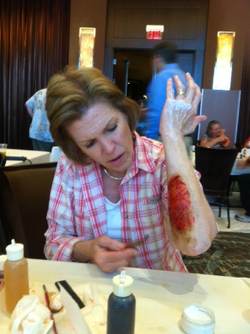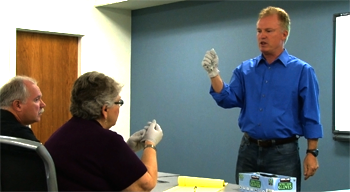Author:
|
Back to Blog
Hand Injuries in Construction3/29/2015  Hand Injuries in Construction A construction worksite can be a real epicenter for hand injuries. A 2011 article in EHS Today cites some scary statistics about the frequency and the expense of such incidents: From the CDC -- Hand injuries send more than 1 million workers to the emergency room annually in the United States. From the U.S. Bureau of Labor Statistics -- When cuts and lacerations of the fingers and hands are combined, the number of days-away-from work cases (approximately 110,000 annually), are second only to back strains and sprains, From the National Safety Council -- The average direct cost of a laceration = $10,000; Stitches = $2,000 plus indirect costs, such as time away from work; Severed tendon = $70,000. Lost time, costly expenses, and workers who can no longer do their job tasks — there are many reasons hand injuries are a real issue for the construction industry. Step one to preventing these sorts of incidents begins with the right gloves for the job. For a 60% improvement in the relative risk for hand injury, be sure your workers have the correct gloves, that those gloves fit properly, and that they are actually worn. No slipping off the gloves “for just a moment so I can more easily finish this task.” Glove manufacturers use high-tech fibers and materials to make the outstanding PPE gloves available on the market today. They are created with a focus on touch sensitivity and dexterity, which are key to a worker’s successful experience wearing gloves on the job. Gone are the days of clumsy, ill-fitting gloves that hinder tasks, so gloves should always been worn as appropriate for the task. Good safety training drives the point home about the seriousness of hand injuries, and emphasizes the importance of engineered safety devices like machine guards (and why we should never disable or bypass them), as well as the best practices to follow to help avoid injury. Summit’s Hand Safety course includes information relevant for multiple facilities, including laboratories and manufacturing sites such as steel mills and automotive parts makers. Hand Safety covers:
To take a class or more information call (503)538-2610 or www.cprnorthwest.com
0 Comments
Read More
Back to Blog
New OSHA Reporting Requirements3/22/2015  Are You Prepared for New OSHA Reporting Requirements? This may be a recap for you, but we wanted to reiterate the importance of the Occupational Safety and Health Administration’s (OSHA) new reporting requirements that went into effect January 1, 2015. Previously, all employers under the federal jurisdiction of OSHA were required to report all workplace fatalities and when three or more workers were hospitalized in the same incident, but the same employers are now required to report on an expanded list of severe injuries:
It’s important to remember that these updated reporting requirements are not simply paperwork but have a life-saving purpose: they will help employers and workers prevent future injuries by identifying and eliminating the most serious workplace hazards. Ensure Your Site is OSHA-Compliant with Pre-Audit Inspections According to the OSHA Budget Justification, as a result of increased identified health issues, the organization plans to increase the number of health inspections occurring in the 2015 fiscal year. Are you prepared? To take a BBP class or find out more call us at 503-538-2610
Back to Blog
First Aid Statistics – 7 Facts3/9/2015  Safe practices at work, home, and play can prevent many injuries, illnesses, and deaths. Once injury or sudden illness has occurred, effective first aid can be the difference between a rapid or prolonged recovery, a temporary or permanent disability, and even life or death. If that isn't motivation enough to make sure that you and your employees are first aid and CPR/AED trained, wait until you read the statistics. The Occupational Safety and Health Administration, OSHA, defines first aid as “emergency care provided for injury or sudden illness before professional emergency medical treatment becomes available.” The statistics for workplace and home injuries and deaths are alarming.* An incident can happen anywhere and to anyone iSafe practices at work, home, and play can prevent many injuries, illnesses, and deaths. Once injury or sudden illness has occurred, effective first aid can be the difference between a rapid or prolonged recovery, a temporary or permanent disability, and even life or death. If that isn't motivation enough to make sure that you and your employees are first aid and CPR/AED trained, wait until you read the statistics. The Occupational Safety and Health Administration, OSHA, defines first aid as “emergency care provided for injury or sudden illness before professional emergency medical treatment becomes available.” The statistics for workplace and home injuries and deaths are alarming.* An incident can happen anywhere and to anyone. Statistics:
Get trained and be prepared for an emergency. *The statistics cited in this article come from OSHA, NIOSH, and the Home Safety Council: Takala, J. “Introductory Report: Decent Work — Safe Work.” International Labour Organization, 2005. http://www.ilo.org/public/libdoc/ilo/2005/105B09_281_engl.pdf Centers for Disease Control and Prevention. “Traumatic Occupational Injuries.” The National Institute for Occupational Safety and Health (NIOSH). http://www.cdc.gov/niosh/injury/ Authorized ASHI and MEDIC First Aid Instructors are ready to help you. You can find a class in your local area by searching our Training Center Directory. For more information or to take a class call 503-538-2610 or www.cprnorthwest.com
Back to Blog
Bloodborne Pathogens (BBP) Training3/2/2015  Teaching bloodborne pathogens (BBP) is a crucial part of any emergency care class. BBP is serious stuff, and people really should be a little apprehensive when it comes to potential contact with bloodborne diseases. Once you understand how easy exposure is, or how infected, dried blood remains infectious even after 7 or more days, you are a lot more motivated to protect yourself when assisting others. That knowledge even makes you a better healthcare consumer, because now you’re watching your providers and making sure they are keeping you safe by following best practices. BBP knowledge is a win-win, and it’s so easy to incorporate into your classes. You start with your customers. Ask them about their BBP training requirements, about their company's Written Exposure Control Plan. Chances are, they’ll say they don’t have one or didn’t know they needed one. But they do need it. BBP training falls under OSHA’s general duty clause, if not specifically referenced (as in the Construction Standard), and that makes it required to be communicated to designated responders and exposed employees. Written Exposure Control Plan templates with “fill-in-the-blanks” can be purchased and the www.osha.gov website has more information on the subject. Now that you have customer buy-in and an exposure plan to work with, what you can do in the classroom itself to get your message about BBP across to your students? Mix it in. ASHI makes it easy to weave BBP into any emergency care training class. If you’re teaching Basic First Aid, just stop the video at the segment on personal safety, and if not conducting a full certification class, spend a little extra time going over BBP in greater detail. Make it part of what you do in every class, since it touches on so many other topics. You can also weave all the components of the 29CFR 1910.1030 requirements throughout the entire CPR/AED/First Aid training, as long as all required topics are covered, company-specific information is supplied, and proper donning/doffing of PPE is practiced. (You've gotta love ASHI for this flexibility!) Make it real. Often customers will let you move your group onto the actual factory floor or shop for a portion of your class time. Being in the actual workplace scene makes it real and immediate for your students. I bring an orange safety cone with a sign explaining that we’re doing a rescue scenario and that this is NOT real blood. I learned that one the hard way, when a nearby worker who was just observing saw the scenario in progress, fainted, and hit his head, giving the company its first recordable accident in over a year. Get permission to be on the floor and announce what you are doing! Be sure you weigh the value of "creative training vs potential problems" when designing your course. Make it fun. As an ice-breaker, I divide my class into three groups. Each group must come up with as many "blood-related" words (bleeding, bloody, etc.) as they can in a couple of minutes. We compare lists, crossing off every word that’s suggested by more than one group. The last group with the most unique words wins some candies or whatever I’ve brought with me. It gets them focused on the topic, gets them engaged in adult learning, and helps everyone lighten up before class starts. Do you have any BBP tips and tricks you would like to share? Please leave a comment below! OSHA requires that BBP class have to be taken once a year if you haven't had your BBP class in a few years you could be open for fines. Your CPR class every 2 years doses not meet this training need. www.cprnorthwest.com or 503-538-2610 |

 RSS Feed
RSS Feed
